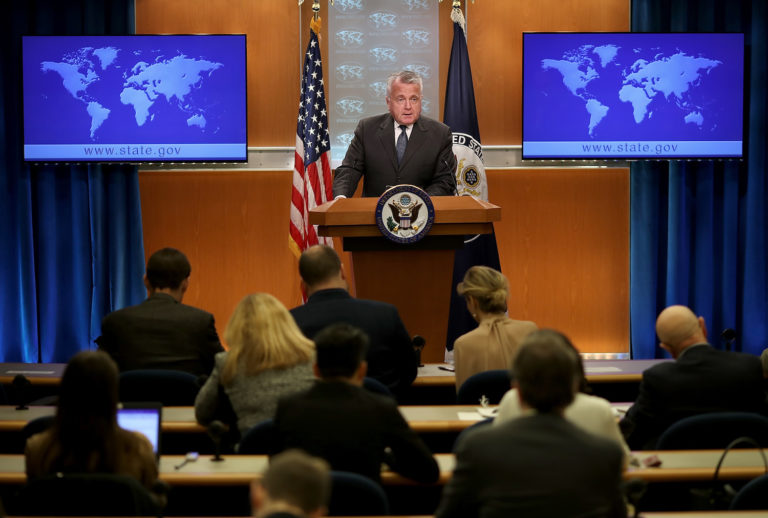Tibetet Segítő Társaság Sambhala Tibet Központ
Tibet Support Association Sambhala Tibet Center
székhely / telephely H-Budapest I. Attila út 123..
(00-36) 70 431 9343 (00-36)70 944 0260 (06-1)782 7721
sambhala@tibet.hu www.tibet.hu tibetpress.info
Facebook/Sambhala Tibet Központ Facebook/Tibett Segítő Társaság
MagnetBank/ 16200010-00110240
IBAN/HU94 16200010 00110240 00000000 SWIFT/HBWEHUHB
(1%) adószám/ 18061347-1-41
nyitva tartás/hétköznap 12.00-20.00 hétvégén előadás függő
» tibeti művészet» lapszemle.hu» thetibetpost.com» eastinfo.hu» rangzen.net» ChoegyalTenzin» tibet.net» phayul.com» DalaiLama.com» vilaghelyzete.blogspot.com» Videók» Linkek» TibetiHírek» Szerkesztőség
Repression “Severe throughout” 2017 in Tibet: Human Rights Report/ENG
2018. április 26./CTA/TibetPress
eredeti cikk
Dharamshala: Last weekend, the U.S. State Department’s Bureau of Democracy, Human Rights and Labor (DRL) in Washington DC released its annual report on the status of global human rights. The country reports evaluate the fundamental freedoms, the rule of law, and the global state of human rights in the past year.
The 2017 annual country reports on human rights practices, the 42nd to be produced, was launched by Acting Secretary of State John Sullivan on April 20. In his remarks delivered at the report launch, Acting Secretary Sullivan said that “China continues to spread the worst features of its authoritarian system, including restrictions on activists, civil society, freedom of expression, and the use of arbitrary surveillance.”
Acting Secretary Sullivan shared concerns over “the absence of an independent judiciary, the governments’ crackdown on independent lawyers and tight controls in information undermine the rule of law.” He further expressed apprehensions about the Chinese authorities’ efforts “to eliminate the religious, linguistic, and cultural identities of Uighur Muslims and Tibetan Buddhists, as well as restrictions on the worship of Christians.”
Tibet and the human rights situation on the Tibetan plateau was cover with China, including the human rights in Hong Kong and Macau. The section highlighted the repression in Tibet (Tibet Autonomous Region and other Tibetan areas), which was “severe throughout the year but increased in the periods before and during politically and religiously sensitive anniversaries and events”.
Underlining the arbitrary detentions and disappearances of Tibetans for “indefinite periods,” the country report highlighted the disappearance case of Panchen Gedhun Choekyi Nyima, who turned 29 this week, but has been “missing” for 23 years. “The whereabouts of the 11th Panchen Lama, Gedhun Choekyi Nyima, the second-most prominent figure after the Dalai Lama in Tibetan Buddhism’s Gelug school, remained unknown. Neither he nor his parents have been seen since Chinese authorities took them away in 1995 when he was six years old,” specified the report. It also listed some cases of torture and other cruel, inhuman treatment of Tibetans known in the past year, including self-immolations related cases. Khedrup, a Tibetan doctor from Machu county in Gansu province who was tortured and beaten for more than one month for sharing clips of Tashi Rabten’s self-immolation to international media, as well as the “local police severely beat[ing] and tortur[ing] approximately 10 relatives of Tibetan farmer Pema Gyaltsen (or Pegyal) of Nyagrong county [..] after they inquired about Pegyal’s conditions following his self-immolation on March 18” were specified in the report.
Tibetan self-immolation protests inside Tibet have reached to 152 so far. In recent years, the DRL noted a decline in reported self-immolations due “to tightened security by authorities, the collective punishment of self-immolators’ relatives associates.”
The report on China also noted that according to the Congressional-Executive Commission on China as last year, 507 Tibetan political prisoners are known to be detained or imprisoned but observers believe that the actual number is much higher. It also pointed out reports of recently released prisoners becoming permanently disabled or in extremely poor health due to harsh treatment they endured in prison.
The annual country report further divulged restrictions on freedom of expression, press and media, censorship and internet freedom, and religious freedom. The lack of Tibetan-language education in public schools and religious education in monasteries, despite Tibetan being an official language in Tibet Autonomous Region besides Mandarin Chinese, has “continued to disrupt traditional living patterns and customs and accelerate forced assimilation.” The destruction of Larung Gar and Yachen Gar, Tibetan Buddhist education centers in Kardze prefecture in 2016 have caused further harm to the illiteracy problem in Tibetan areas.
Tibet continues to remain severely restricted for travel, including the restrictions in attending the 2017 Kalachakra, as well as in-country movement for Tibetans, particularly for monks and nuns traveling to and from the TAR, who encountered scrutiny and difficulties.
The annual report also shed light on the concerns over development projects, economic and social exclusion of Tibetans, and continued government campaign of resettling Tibetan nomads, all of which have caused discontent among the Tibetans.
Meanwhile, the Washington D.C.-based Freedom House also released its report on international press freedom called “Attacks on the Record: The State of Global Press Freedom, 2017-2018”. The Freedom House report noted in its key findings that “Internet censorship and surveillance reached new heights in China as a Cybersecurity Law came into effect in June 2017, alongside other new regulations restricting online communications and the use of virtual private networks (VPNs).” A number of bloggers and social media users’ arrest or imprisonment for their online comments or efforts to share information about human rights were reported in 2017, indicated the Global Press Freedom report.
(To read the full Country Report on China, click here.)
-Report filed by UN, EU and Human Rights desk, DIIR-
